Chaim Soutine
Chaïm Soutine (13 January 1893 – 9 August 1943) was a Russian[1] painter who made a major contribution to the expressionist movement while living and working in Paris.
Chaïm Soutine | |
|---|---|
 Chaim Soutine (with signature) | |
| Born | 13 January 1893 |
| Died | 9 August 1943 (aged 50) Paris, France |
| Education | Vilna Academy of Fine Arts, École des Beaux-Arts, Fernand Cormon |
| Known for | Painting |
| Movement | Expressionism |
| Patron(s) | Albert C. Barnes, Leopold Zborowski |
Inspired by classic painting in the European tradition, exemplified by the works of Rembrandt, Chardin[2] and Courbet, Soutine developed an individual style more concerned with shape, color, and texture over representation, which served as a bridge between more traditional approaches and the developing form of Abstract Expressionism.
Biography
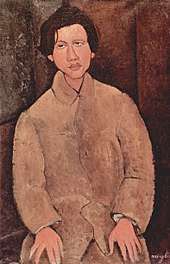
.jpg)
Soutine was born Chaim Sutin, in Smilavichy in the Minsk Governorate of the Russian Empire (present-day Belarus). He was the tenth of eleven children. From 1910 to 1913 he studied in Vilnius at a small art academy.[3] In 1913, with his friends Pinchus Kremegne and Michel Kikoine, he emigrated to Paris, where he studied at the École des Beaux-Arts under Fernand Cormon. He soon developed a highly personal vision and painting technique.
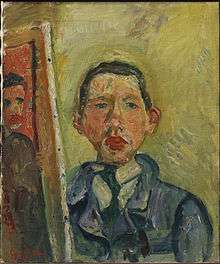
For a time, he and his friends lived at La Ruche, a residence for struggling artists in Montparnasse where he became friends with Amedeo Modigliani. Modigliani painted Soutine's portrait several times, most famously in 1917, on a door of an apartment belonging to Léopold Zborowski, who was their art dealer.[4] Zborowski supported Soutine through World War I, taking the struggling artist with him to Nice to escape the possible German invasion of Paris.
After the war Paul Guillaume, a highly influential art dealer, began to champion Soutine's work. In 1923, in a showing arranged by Guillaume, the prominent American collector Albert C. Barnes, bought 60 of Soutine's paintings on the spot. Soutine, who had been virtually penniless in his years in Paris, immediately took the money, ran into the street, hailed a Paris taxi, and ordered the driver to take him to Nice, on the French Riviera, more than 400 miles away.
Soutine once horrified his neighbours by keeping an animal carcass in his studio so that he could paint it (Carcass of Beef). The stench drove them to send for the police, whom Soutine promptly lectured on the relative importance of art over hygiene. There's a story that Marc Chagall saw the blood from the carcass leak out onto the corridor outside Soutine's room, and rushed out screaming, 'Someone has killed Soutine.'[5] Soutine painted 10 works in this series, which have since become his most well-known. His carcass paintings were inspired by Rembrandt's still life of the same subject, Slaughtered Ox, which he discovered while studying the Old Masters in the Louvre. Soutine produced the majority of his works from 1920 to 1929. From 1930 to 1935, the interior designer Madeleine Castaing and her husband welcomed him to their summer home, the mansion of Lèves, becoming his patrons, so that Soutine could hold his first exhibition in Chicago in 1935. He seldom showed his works, but he did take part in the important exhibition The Origins and Development of International Independent Art held at the Galerie nationale du Jeu de Paume in 1937 in Paris, where he was at last hailed as a great painter. Soon afterwards France was invaded by German troops. As a Jew, Soutine had to escape from the French capital and hide in order to avoid arrest by the Gestapo. He moved from one place to another and was sometimes forced to seek shelter in forests, sleeping outdoors. Suffering from a stomach ulcer and bleeding badly, he left a safe hiding place for Paris in order to undergo emergency surgery, which failed to save his life. On 9 August 1943, Chaim Soutine died of a perforated ulcer. He was interred in Cimetière du Montparnasse, Paris.
Legacy
In February 2006, an oil painting of his controversial and iconic series Le Bœuf Écorché (1924) sold for a record £7.8 million ($13.8 million) to an anonymous buyer at a Christie's auction held in London—after it was estimated to fetch £4.8 million. In February 2007, a 1921 portrait of an unidentified man with a red scarf (L'Homme au Foulard Rouge) sold for $17.2 million—a new record—at Sotheby's London auction house. In May 2015, Le Bœuf, circa 1923, oil on canvas, achieved a record price for the artist of $28,165,000 at the Christie's curated auction Looking forward to the past.
One of the beef paintings, known as “Le boeuf,” was sold for $1 million in 2004 and resold six months later for twice that price to the National Gallery of Art in Washington, D.C.. Heirs of the first seller sued to have the painting returned, claiming the price was unfairly low, and a complex settlement in 2009 required the painting to be transferred to them. [6]
Some years after Soutine's death, Roald Dahl placed him as a character in his short story "Skin".[7]
The Jewish Museum in New York has presented major exhibitions of Soutine's work in An Expressionist in Paris: The Paintings of Chaim Soutine[8] (1998) and Chaim Soutine: Flesh (2018).[9]
Gallery
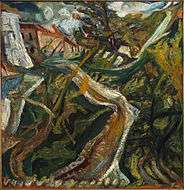 Chemin de la Fontaine des Tins at Céret, ca. 1920, Henry and Rose Pearlman Collection on long-term loan to the Princeton University Art Museum
Chemin de la Fontaine des Tins at Céret, ca. 1920, Henry and Rose Pearlman Collection on long-term loan to the Princeton University Art Museum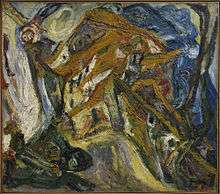 View of Céret, ca. 1921–22, Henry and Rose Pearlman Foundation on long-term loan to the Princeton University Art Museum
View of Céret, ca. 1921–22, Henry and Rose Pearlman Foundation on long-term loan to the Princeton University Art Museum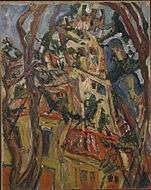 Steeple of Saint-Pierre at Céret, ca. 1922, Henry and Rose Pearlman Foundation on long-term loan to the Princeton University Art Museum
Steeple of Saint-Pierre at Céret, ca. 1922, Henry and Rose Pearlman Foundation on long-term loan to the Princeton University Art Museum
Footnotes
- Getty Research Institute: Union List of Artist Names Online. Retrieved 20 June 2020.
- Kleeblatt, 13
- Giraudon, Colette (2003). "Soutine, Chaïm". Grove Art Online.
- Kleeblatt et al., 101
- Wullschlager, Jackie (2008). Chagall - Love and Exile. Allen Lane. p. 154. ISBN 978-0-7139-9652-4.
- Mitchell Martin (1 June 2009). "Soutine Suit Settled Over Bargain Beef". ArtInfo. Archived from the original on 19 September 2018.
- "Skin". 30 November 2015.
- "An Expressionist in Paris: The Paintings of Chaim Soutine". The Jewish Museum. Retrieved 1 May 2018.
- "Chaim Soutine: Flesh". The Jewish Museum. Retrieved 1 May 2018.
References
- Kleeblatt, Norman L.; Kenneth E. Silver (1998). An Expressionist in Paris: The Paintings of Chaim Soutine. New York City: Prestel. ISBN 3-7913-1932-9.
- Mullin, Rick (2012). Soutine: A Poem. Loveland, Ohio: Dos Madres Press. ISBN 978-1-933675-68-8.
- Tuchman, Maurice; Chaim Soutine (1893–1943) , Los Angeles County Museum of Art, 1968
- Tuchman, Maurice; Esti Dunow (1993) Chaim Soutine (1893–1943): catalogue raisonné. Köln: Benedikt Taschen Verlag.
- Soutine: The power and the fury of an eccentric genius by Stanley Meisler
- Ifkovic, Ed. Soutine in Exile: A Novel. Createspace, 2017.
External links
| Wikimedia Commons has media related to Chaim Soutine. |
| Wikiquote has quotations related to: Chaim Soutine |